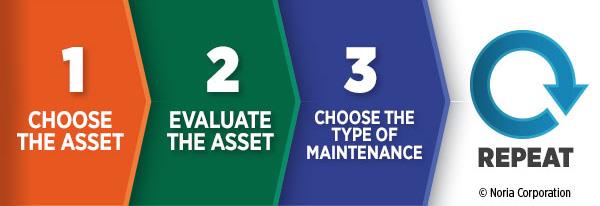Reliability-centered Maintenance (RCM) is used in the maintenance and engineering industries to optimize the reliability and maintainability of equipment, systems, and processes.

RCM is a structured and systematic approach that helps organizations identify the most effective and efficient maintenance strategies to reduce downtime, improve safety, and minimize costs.
If you are a maintenance or operations professional looking to improve your organization's equipment performance, reduce downtime, and minimize costs, this article is for you. This article will explore the principles, process, benefits, and challenges of implementing Reliability-Centered Maintenance and provide insights and practical tips to help you apply RCM in your organization.
History
RCM was developed in the late 1960s by the commercial aviation industry in the United States. The Federal Aviation Administration (FAA) recognized the need to reduce the high maintenance costs and plane accidents caused by inadequate maintenance. As a result, the FAA funded a study called the Maintenance Steering Group (MSG), led by United Airlines, and involved 15 major airlines.
The MSG study developed a systematic process for maintenance strategies emphasizing reliability, safety, and cost-effectiveness. This process became known as Reliability-Centered Maintenance and was adopted by the military, nuclear power plants, and other industries.
Principles
Reliability-centered Maintenance is based on several principles that guide the development of maintenance strategies. These principles include:
- Equipment Function and Failure: The first step in RCM is identifying the equipment's function and potential failure modes. This involves understanding the equipment's design, operating conditions, and failure mechanisms.
- Criticality Analysis: After identifying potential failure modes, a criticality analysis is performed to determine the consequences of each failure mode. This involves assessing the impact of the failure on safety, the environment, production, and costs.
- Maintenance Strategies: Based on the criticality analysis, maintenance strategies are developed to prevent, detect, or mitigate the consequences of each failure mode. These strategies can include preventive maintenance, predictive maintenance, or corrective maintenance.
- Risk Management: RCM also involves a risk management process that assesses the risk associated with each maintenance strategy. The risk assessment considers the likelihood of the strategy's success, the consequences of failure, and the cost of implementing the strategy.
- Optimization: Finally, the maintenance strategies are optimized to balance the risk, cost, and reliability goals of the organization. This involves selecting the most effective and efficient maintenance strategies based on the risk assessment.
Implementation
 RCM workflow (Source: ReliablePlant)
RCM workflow (Source: ReliablePlant)
The implementation of Reliability-Centered Maintenance involves several steps requiring various stakeholders' involvement. These steps include:
- Define the Scope: The first step is to define the scope of the RCM analysis. This involves identifying the equipment or system to be analyzed, the functional requirements, and the performance metrics.
- Team Formation: The next step is to form an RCM team that includes subject matter experts, equipment operators, maintenance personnel, and other stakeholders. The team should understand the equipment or system being analyzed and its operational context.
- Equipment Function and Failure Analysis: The RCM team then performs a detailed analysis of the equipment's functions and potential failure modes. This involves identifying the equipment's design, operating conditions, and failure mechanisms.
- Criticality Analysis: Once the potential failure modes have been identified, a criticality analysis is performed to determine the consequences of each failure mode. This involves assessing the impact of the failure on safety, the environment, production, and costs.
- Maintenance Strategies: Based on the criticality analysis, the RCM team develops maintenance strategies to prevent, detect, or mitigate the consequences of each failure mode. These strategies can include preventive maintenance, predictive maintenance, or corrective maintenance.
- Risk Assessment: The RCM team then assesses the risk associated with each maintenance strategy. This involves considering the likelihood of success, the consequences of failure, and the cost of implementing the strategy.
- Strategy Optimization: Finally, the RCM team optimizes the maintenance strategies to balance the risk, cost, and reliability goals of the organization. This involves selecting the most effective and efficient maintenance strategies based on the risk assessment.
- Implementation and Monitoring: Once the maintenance strategies have been optimized, they are implemented and monitored to test their effectiveness. This involves tracking key performance metrics, such as equipment uptime, maintenance costs, and safety incidents, to ensure the maintenance strategies achieve the desired results.
Benefits
Reliability-Centred Maintenance offers several benefits to organizations that implement it. These benefits include:
- Improved Equipment Reliability: RCM helps organizations optimize maintenance strategies to improve equipment reliability and minimize downtime.
- Increased Safety: RCM emphasizes safety as a critical factor in developing maintenance strategies, which helps organizations reduce the risk of accidents and injuries.
- Cost Savings: RCM helps organizations identify the most cost-effective maintenance strategies to reduce maintenance costs and improve equipment performance.
- Compliance with Regulations: RCM helps organizations follow regulatory requirements related to equipment maintenance and safety.
- Better Decision Making: RCM provides organizations with a systematic approach to decision-making that considers the impact of maintenance strategies on safety, reliability, and costs.
Challenges
Despite its many benefits, Reliability-Centered Maintenance also presents several challenges to organizations that implement it. These challenges include:
- Resource Requirements: RCM requires a significant investment of time, money, and personnel to implement effectively.
- Organizational Resistance: Some organizations may resist the changes required to implement RCM, mainly if it involves shifting away from traditional maintenance practices.
- Data Availability: RCM relies on accurate and comprehensive data to develop effective maintenance strategies. But, some organizations may need help to collect and analyze the necessary data for RCM.
- Complexity: RCM is a complex method that requires specialized knowledge and expertise to implement effectively.
Consulting and Training
RCM is a systematic approach to maintenance that emphasizes reliability, safety, and cost-effectiveness. RCM helps organizations optimize maintenance strategies to improve equipment reliability, reduce downtime, and minimize costs. While RCM presents several challenges to organizations implementing it, its benefits make it a practical method for any organization looking to improve its maintenance practices. By following the principles and implementation process of RCM, organizations can achieve better equipment performance, increased safety, and significant cost savings.
If you want to implement an RCM program in your organization, consider partnering with a reliable and experienced provider like CRE Philippines. Besides consulting services, we also offer a comprehensive oil analysis and training program that can help you track the health of your equipment and identify potential issues before they become costly problems. Contact us today to learn how we can help you optimize your maintenance strategies and improve your equipment's reliability.
Source:
Trout, J. (n.d.). How to Implement Reliability-Centered Maintenance. ReliablePlant. Retrieved from https://www.reliableplant.com/reliability-centered-maintenance-31577


